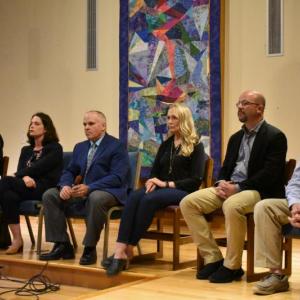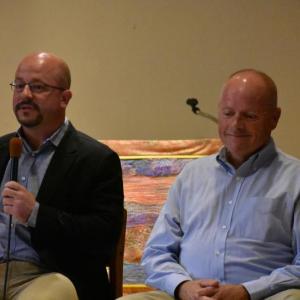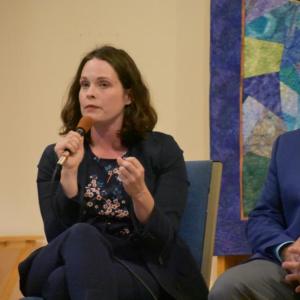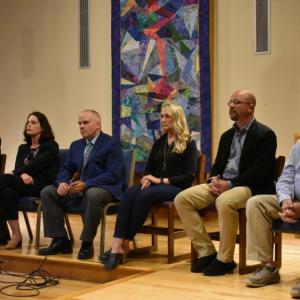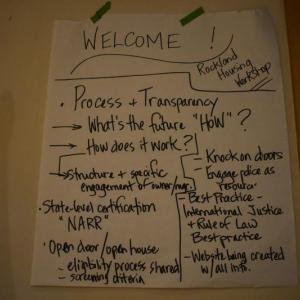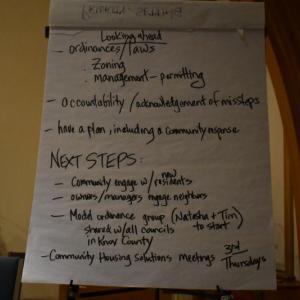Rockland Reentry House forum answers technical questions, Talbot Ave residents demand more talks
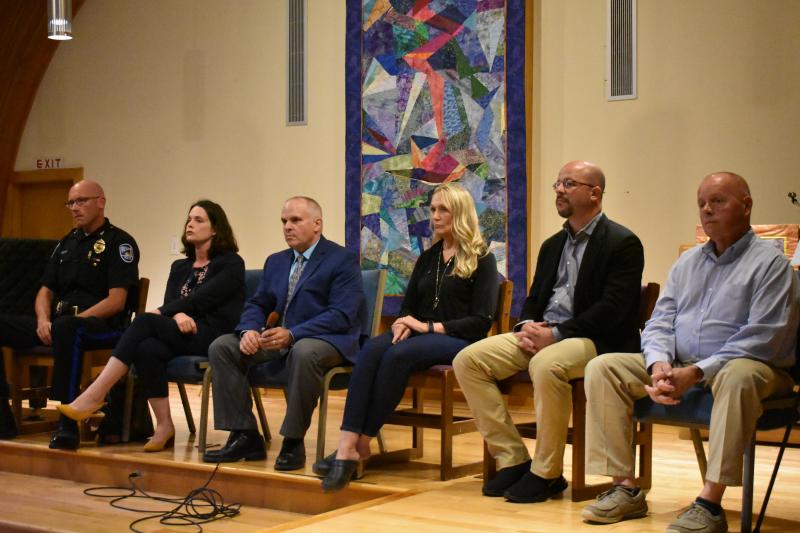 Left to right: Rockland Police Chief Chris Young; District Attorney Natasha Irving; Bruce Noddin, founder of Maine Prisoner Re-entry Network; Tanja Barbour, co-founder of Freedom House; Peter Horch, owner of Horch Roofing; and Sean Crothers, co-founder of Gorham’s Courage House. (Photo by Sarah Thompson)
Left to right: Rockland Police Chief Chris Young; District Attorney Natasha Irving; Bruce Noddin, founder of Maine Prisoner Re-entry Network; Tanja Barbour, co-founder of Freedom House; Peter Horch, owner of Horch Roofing; and Sean Crothers, co-founder of Gorham’s Courage House. (Photo by Sarah Thompson)
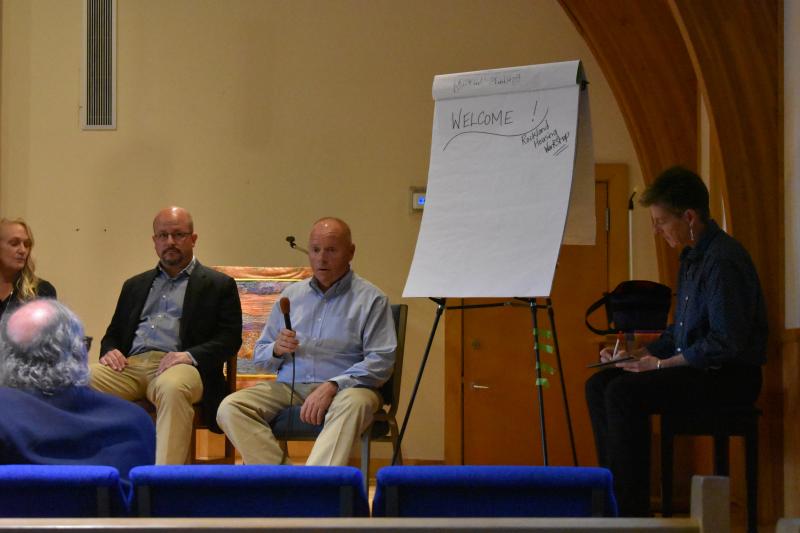 At left, Carol Kelly, facilitator of this forum as well as past Rockland forums, prepares to begin the discussion. (Photo by Sarah Thompson)
At left, Carol Kelly, facilitator of this forum as well as past Rockland forums, prepares to begin the discussion. (Photo by Sarah Thompson)
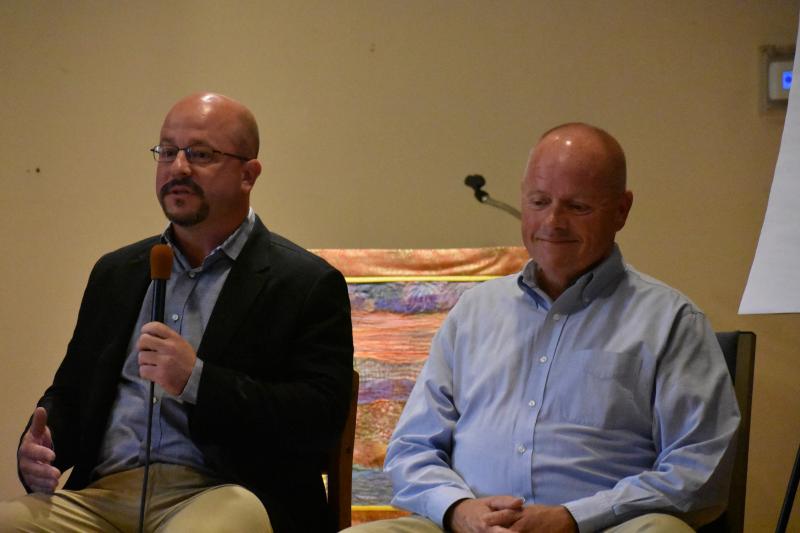 Peter Horch and Sean Crothers. (Photo by Sarah Thompson)
Peter Horch and Sean Crothers. (Photo by Sarah Thompson)
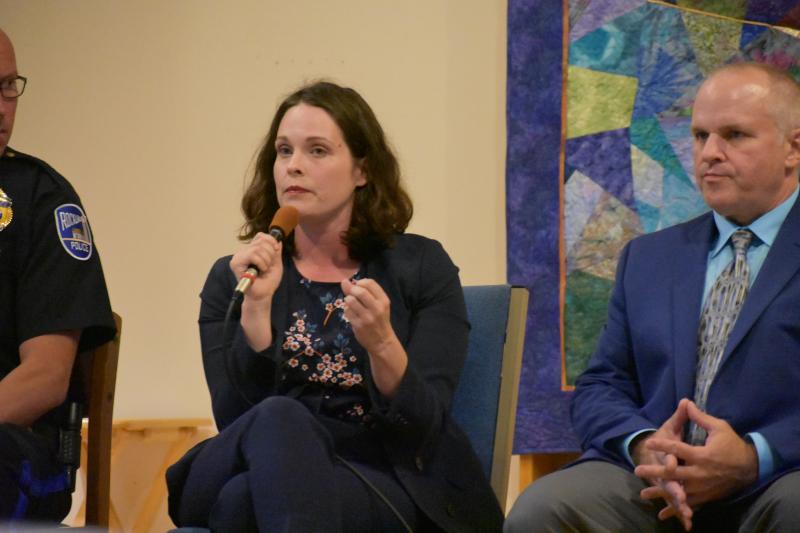 Natasha Irving speaks as Bruce Noddin listens. (Photo by Sarah Thompson)
Natasha Irving speaks as Bruce Noddin listens. (Photo by Sarah Thompson)
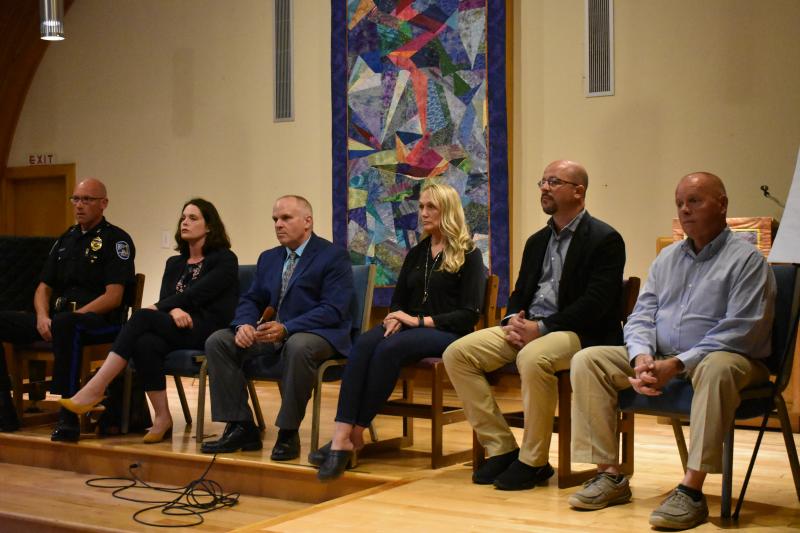
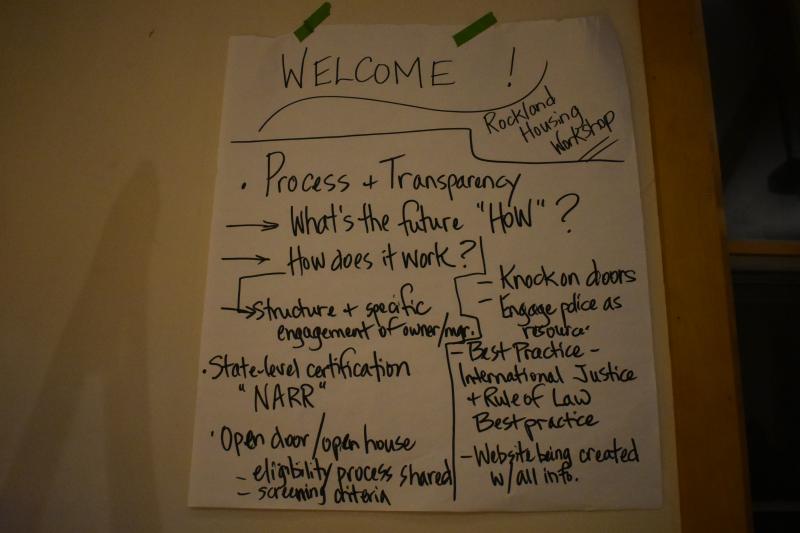 (Photo by Sarah Thompson)
(Photo by Sarah Thompson)
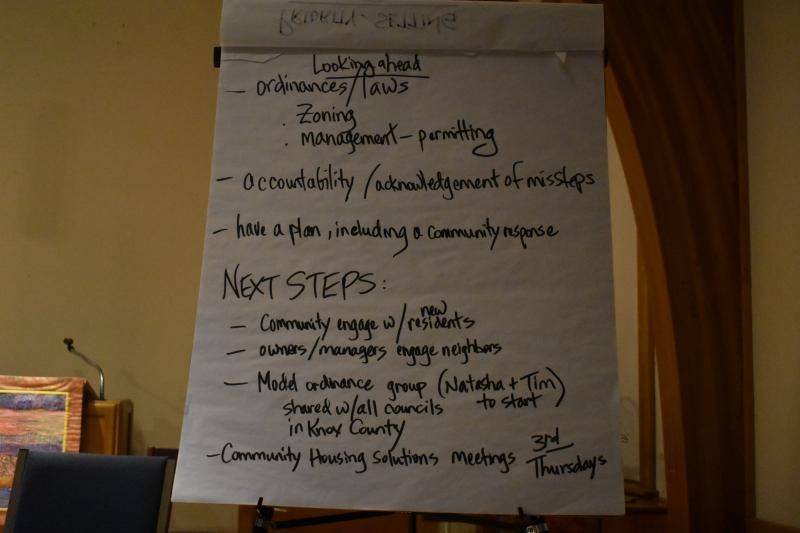 (Photo by Sarah Thompson)
(Photo by Sarah Thompson)
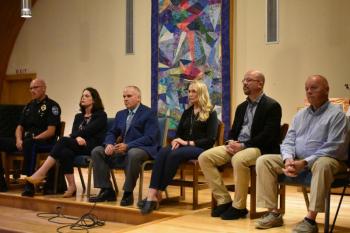 Left to right: Rockland Police Chief Chris Young; District Attorney Natasha Irving; Bruce Noddin, founder of Maine Prisoner Re-entry Network; Tanja Barbour, co-founder of Freedom House; Peter Horch, owner of Horch Roofing; and Sean Crothers, co-founder of Gorham’s Courage House. (Photo by Sarah Thompson)
Left to right: Rockland Police Chief Chris Young; District Attorney Natasha Irving; Bruce Noddin, founder of Maine Prisoner Re-entry Network; Tanja Barbour, co-founder of Freedom House; Peter Horch, owner of Horch Roofing; and Sean Crothers, co-founder of Gorham’s Courage House. (Photo by Sarah Thompson)
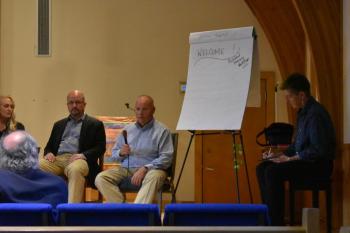 At left, Carol Kelly, facilitator of this forum as well as past Rockland forums, prepares to begin the discussion. (Photo by Sarah Thompson)
At left, Carol Kelly, facilitator of this forum as well as past Rockland forums, prepares to begin the discussion. (Photo by Sarah Thompson)
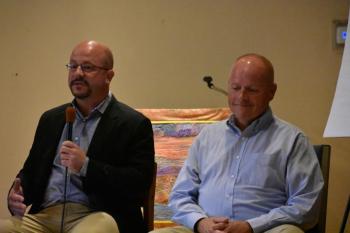 Peter Horch and Sean Crothers. (Photo by Sarah Thompson)
Peter Horch and Sean Crothers. (Photo by Sarah Thompson)
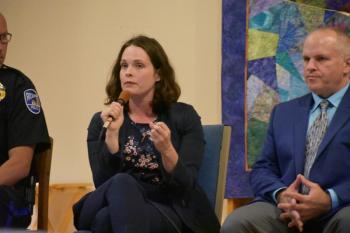 Natasha Irving speaks as Bruce Noddin listens. (Photo by Sarah Thompson)
Natasha Irving speaks as Bruce Noddin listens. (Photo by Sarah Thompson)
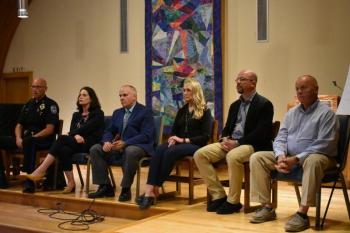
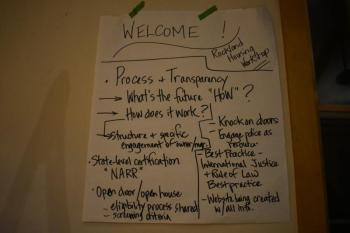 (Photo by Sarah Thompson)
(Photo by Sarah Thompson)
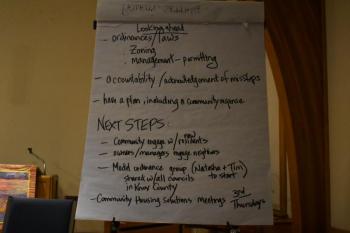 (Photo by Sarah Thompson)
(Photo by Sarah Thompson)
ROCKLAND — “Your neighborhood is now safer,” said Bruce Noddin, founder of Maine Prisoner Re-entry Network, “because we now know where these folks are, and they have programming.”
With several Talbot Avenue residents still fuming over having only learned of a proposed reentry house on their street due to a news article and subsequent word of mouth, a panel of officials sought to ease the community’s fears, Tuesday, Sept. 25, in Rockland.
By the end of the two-hour forum, however, Talbot residents were still demanding a workshop that they’d been asking for. Yet, none of them were able to answer forum facilitator Carol Kelly’s question of what is left to discuss. One neighbor filled the silence by stating a simple desire to keep talking, and another wanted to have officials in attendance of the residents’ choosing, not those hand-picked by a select group.
On Tuesday, a panel of six people connected to the reentry system sat on the Universalist Church stage in Rockland and shared their thoughts on why reentry and recovery houses, such as the future Unity House, are assets to the community.
That panel included Rockland’s police chief, the district attorney, a Bolduc Correction’s Facility reentry official, a co-founder of a recovery house on Limerock Street, a former alcoholic and prisoner who has established a successful reentry house, called Courage House, in Gorham, and a local employer with success stories of the work-release program only to lose those employees due to lack of housing.
Many in the audience, however, remained focused on the Talbot Street’s Unity House and owner Kathryn Matlack’s handling of the property’s purchase in late June. Some attempted to extract admissions of guilt from the panel.
“The ordinances of Rockland got it wrong,” said one resident. “And that’s what we want to see addressed. We are concerned with how it was allowed in by the ordinances, and that’s been our main concern. We as a neighborhood are in favor of the work that has to be done, and feel that it is important to be done.”
Most on the panel, however, chose to look beyond residents’ continued demands for full transparency of the Unity House, which includes viewing the policies and guidelines. The House has yet to be lived in. A website is being created, and the reentry house in Gorham is being used as a guide, though not in all aspects.
Officials chose, instead, to look toward the future in regards to local and state ordinances as well as best practices moving forward.
District Attorney Natasha Irving offered to work with Tim Cheney, of Enso Recovery, to discover what the best model ordinances are that can be presented to a planning committee.
“To me, this is two-fold,” she said. “To treat people like human beings who are coming back into our community with addiction. And to make sure our communities who are accepting these folks know that there is a safe, structured way happening.”
An average of 100 former Bolduc prisoners re-enter the community every month, regardless of whether systems are in place to help with the reintegration process, according to Noddin.
Those people are out of prison or jail, and in order for them to reintegrate successfully, they need structure, starting with housing. The ones who live in the reentry houses are accounted for, screened, referred, and approved. They’re the ones with curfews, job requirements, household expectations, mentors, and obligations to attend pro-social activities such as church, volunteering, or keeping up with counseling sessions.
The reference to “pro-social” garnered a comment from opponent Leif McDonald, who questioned the expectation of pro-social Unity House tenants when their own administration allegedly isn’t “pro-social.”
Talbot Street residents criticize House founder and property owner Matlack for not knocking on doors to inform neighbors prior to obtaining her land deed. In general a proactive outreach strategy is a useful tool, according to D.A. Natasha Irving, but not required.
“We live in Maine,” said Irving. “We live in Midcoast Maine. Everybody knows everybody. And if you don’t, then you will soon.”
Limerock Street’s Freedom House founders never thought to inform Limerock neighbors, according to co-founder Jake Barbour. Barbour his wife, Tanja, had already been working with the incarcerated through their ministry approach and had begun seeing the prisoners as family.
Not only do some residency programs in other communities refrain from knocking on doors ahead of time in order to attempt gaining neighborhood support, many proposed residency projects silently slide into communities under the radar. Others are encouraged to avoid publicly announcing their plans, said Maine Prisoner Re-entry Network founder Bruce Noddin.
Matlack, on the other hand, has been attending monthly meetings of the Creative Housing Solutions Committee, a subcommittee of the Maine Prison Reentry Network, along with Noddin and Knox County Sheriff Tim Carroll, at Rockland’s Career Center, according to Noddin. Meetings are open to the public, every third Thursday of the month. The next meeting will be Oct. 17, at 5:30 p.m., at 24 Lincoln Street.
Rockland Police Chief Chris Young said his positive outlook of the Unity House project officially came after attending an open house there last week, though he’d been developing an interest in the general reentry housing concept since attending a Rockland forum 1.5 years ago.
“I thought about the whole concept of bringing people out – back into society in a structured environment where they had job opportunities, they had services that they could get for mental health, for substance abuse, and they had structure and support 24/7. And I thought, ‘what a great idea.’ Because I’ve seen the other side of it. I’ve seen what happens when they get out of prison, or they get out of jail. They don’t have support. They don’t have services. And where do they end up? A lot of them end up back where they started.
“I’m your police chief,” he said. “I’m responsible for the safety of over 7,000 residents. I have 17 men and women who wear the same uniform that I wear. That is not a responsibility that any of us takes lightly....Your safety is paramount to me and my agency.”
Young stressed that he cared about the safety of ALL residents, and that he wanted the public to view the police department as a resource.
Irving and Cheney promised to look into best-practice ordinances and may have something to present to Rockland residents in a few months.
Some statements floated during the forum:
– The difference between Reentry and Recovery houses? Reentry are regulated and have specific requirements with location, according to Tim Cheney, Enso Recovery, which works with area jails. Recovery is protected under the Disabilities Act.
—-Only 27 Houses in Maine that are NARR certified (National Alliance for Recovery Residences) out of approximately 110, according to Bruce Noddin. $3 million in grants has now been allocated to start inspecting more. There is no state law or regulation that applies to this.
–One Talbot resident stated that he was initially excited about having a reentry house in close proximity. He envisioned taking his Bible studies into the house. But after hearing from neighbors and the media about all the potential negative sides, he has become an opponent.
–Another neighbor wanted such houses zoned out of residential neighborhoods. Irving called that a ‘Slippery Slope’ of segregation. The goal, according to Noddin, is to integrate former prisoners into neighborhoods, and not create slums and projects. Former inmates can’t learn if they are kept away.
– Between 110 and 120 Bolduc work-release inmates are already in the community every day, contributing to the local economy, according to Noddin. A lot of them are being offered full-time jobs before their releases. Which leads to the problem seen by Peter Horch, of Horch Roofing. Horch took advantage of the work-release program a couple of years ago, and his business has benefited greatly. Though a couple of inmates didn’t work out, Horch had more of a problem retaining workers due to lack of housing. Horch told the forum that he lives on Route 90 and would favor such a reentry residence across the street.
“If they are working, then they are paying taxes and therefore giving back to the community,” said Noddin. “The other thing is that they are taxpayer savings, because if they are not back inside of a facility, we’re not, as paying taxpayers, paying that estimated $45-55,000 per year.”
Reach Sarah Thompson at news@penbaypilot.com
Event Date
Address
United States

